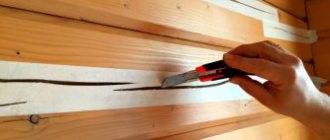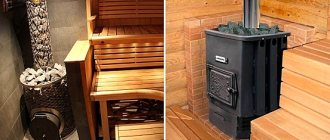One of the important decisions for every developer is the choice of roofing material. Among the wide variety, it is difficult to choose a specific material. One of the common materials used by our ancestors is roofing shingles. It is quite strong, durable and has an attractive appearance. It’s not for nothing that our ancestors loved it so much, and it has survived to this day.
And if previously a shingle roof was cheap and easy to install, now a wooden roof is not a luxury for everyone. Experienced craftsmen who know all the intricacies of working with the material are becoming scarce. However, those who want to see this particular roofing option can do all the work themselves. Thanks to this article, you will learn what roofing shingles are, how roofing shingles are made, as well as the advantages and disadvantages of the material.
The difference between shingles and shingles

Shingles and shingles - types of wooden shingles
These materials have a similar structure, but have a number of differences. Shingles are small-thick wood plates cut from a block in the longitudinal direction. A roof with such a coating is installed in 4-8 layers. The standard length of one element can vary between 40-100 cm, width - 9-13 cm, thickness does not exceed 5 mm.
Roofing material shingles are wedge-shaped planks, the length of which is 40-60 cm, and the width is up to 14 cm. On the thickened edge there is a 12 mm groove for installation. During processing, the raw material is sawn longitudinally, which allows it to maintain decent strength and ensure a long service life of the finished coating.
The advantage of natural coating
Wooden plates are breathable, so the roof is ventilated naturally. If you create a roof according to the shingle-roof scheme - an additional ventilated gap, then the covering itself and the supporting structures will last much longer.
Basically, shingles as a roofing covering have the following advantages:
- ensures long-term roof tightness;
- the coating is completely in harmony with the environment;
- lightness of the material (per 1 sq.m. load ranges from 14 to 18 kg);
- without a doubt, this is an environmentally friendly coating;
- During installation work, virtually waste-free production is observed;
- the coating does not accumulate static voltage;
- no condensation forms under the wooden plates;
- resistance to sudden temperature changes, precipitation and wind loads;
- Possibility of use in various climatic conditions, at temperatures from +40 to -70 degrees.
The listed advantages of shingles allow you to create durable and comfortable living in your home using this material.
Types of shingles for roofing
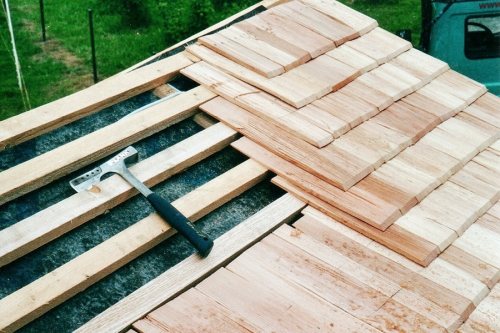
Shredded shingles
The main classification of this material is possible according to the method of processing the raw materials. There are two types – chipped and sawn products.
Stabbed
This variety is made by hand; the finished parts are characterized by increased durability, aesthetic appearance and reliability. The service life of chipped shingles exceeds 50 years, provided that installation requirements are met. The coating is used for finishing roofs and facade works. However, such material has a significant disadvantage: the price can be almost twice the cost of another type. You can save on purchases if you make shingles for the facade with your own hands.
Sawn

Sawn shingles are produced by sawing hemp along the grain
This variety is obtained by processing on an industrial machine, sawing blanks along the fibers. The technology makes it possible to produce a relatively inexpensive, practical material, preserving the structure and design of natural wood. The main advantage is the reduced price, due to which you can save on the installation of the coating.
Sawn shingles for roofing have ideal geometry, a smooth and pleasant-to-touch surface, and ease of installation. However, the product has a small drawback: its service life does not exceed 30-40 years; roof repairs will be required earlier. Durability can be improved by treating the surface with protective compounds, but this increases the cost of the structure.
Production of shingles
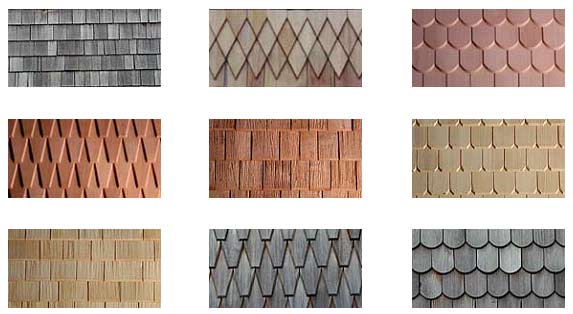
Roofing shingles are made from the best quality coniferous wood: oak, Siberian larch, Canadian cedar. This material is mainly made by hand, in the form of wooden plates.
Shingles can be of several types:
- chopped;
- sawn;
- mosaic.
In order for the material to acquire a certain shade, it is impregnated with special agents, thereby extending its service life.
This material is an excellent alternative to modern roofing coverings, especially for roofs of those objects that are subject to:
- exposure to harsh climates;
- extremely low temperature conditions;
- significant amounts of precipitation in the form of snow cover.
Attention. Wood for shingles must be free of damage: rot and knots.
Material advantages
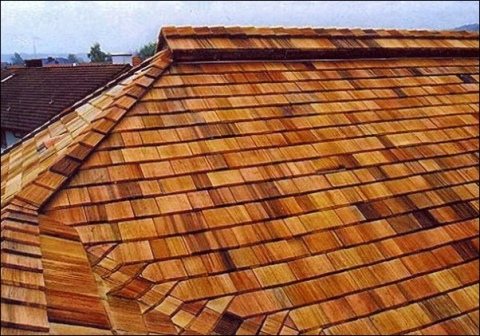
Before laying, the shingles are treated against mold with chemical solutions.
Both roofing shingles and shingles have many positive properties:
- complete sealing of the finished surface due to the multilayer structure;
- increased resistance to wind loads, including hurricane gusts, precipitation, and debris;
- resistance to burnout and sudden thermal fluctuations;
- antistatic properties;
- attractive appearance, emphasizing the wealth and sense of taste of the owner;
- a huge variety of color options and textures, which allows you to choose the ideal solution for every taste;
- the possibility of installing a shingled roof with slopes located at an angle from 18 to 90 degrees;
- quick and relatively simple installation, possible regardless of weather conditions and time of year;
- excellent sound absorption performance;
- an environmentally friendly composition that allows you to create a favorable microclimate under the roof, which is especially important when constructing an attic floor;
- no need to place an additional layer of vapor barrier material under the coating;
- When impregnated with antifungal agents and protective compounds, resistance to mold, parasites and rodents increases.
Compatibility with most classic facade styles and almost any building configuration allows the material to be used for finishing the roof of a private house, cottage, sauna, outbuildings, regardless of number of floors and size.
Laying shingles on the roof
When installing wooden roofs, the slope of the slope for laying shingles should not be less than 15 degrees. The sheathing is performed either as a continuous flooring or in increments equal to one third of the length of the shingles . The bars for the sheathing are chosen with a section of 5x5 or 6x6 cm.
However, in some sources the device of a continuous sheathing is regarded as an extra element. This is motivated by the fact that there will not be a sufficient ventilation gap, which will lead to rapid deterioration of the wood due to rotting.
The same can be said about the construction of a waterproofing carpet. Some sources claim that waterproofing is necessary, others categorically deny it. But I think the latter are right. After all, judging by historical documents, waterproofing as such did not exist at all, and wooden roofs served faithfully for tens, if not hundreds of years.
If in the old days the fastening of shingles was carried out by installing grooves and ridges, now the shingles are fastened with nails previously boiled in drying oil.
Installation of shingles is carried out in several layers. On eaves overhangs, which are most exposed to moisture, additional boards 35-40 cm wide are nailed, and the number of layers of shingles is increased by one.
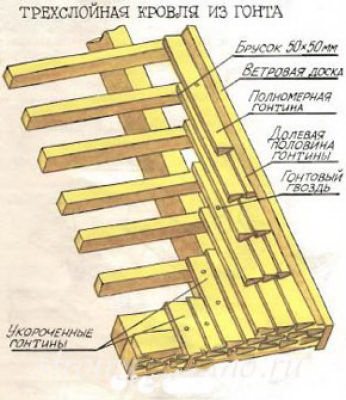
Depending on the functionality of the building, the number of layers of shingles can vary from 2 to 5:
- for non-residential buildings, two layers of roofing shingles are sufficient,
- for residential 3-4 layers, which ensures reliable waterproofing of the under-roof space and the strength of the entire roof.
- For roofs with a slope greater than 45 degrees, it is possible to lay shingles in two layers.
Installation of wooden shingles begins with the eaves overhang. At the same time, one more layer of shingles is laid on the eaves and in such a way that the top row overlaps the first completely and still protrudes above it by a few centimeters. The third row should also overlap the second, protruding above it, and only the fourth row, provided that the entire roof is laid in three layers, does not reach the end of the third row by one third of the length of the shingles.
This scheme for laying shingles completely protects the eaves overhang from moisture flowing from the roof and extends the life of the wooden roof.
The technology for installing roofing shingles is very similar to the design of a fir cone - the arrangement of its scales. Probably, in ancient times, builders borrowed from nature a method of constructing a roof that reliably protected the house from snow, rain and wind.
Design dimensions
On sale you can find various types of products, differing in the sizes of the slats. You can see the ratio of dimensions in the table:
| Length, mm | Width, mm | Thickness, mm |
| 200 | 60-100 | 6-7 |
| 400 | 60-200 | 9-10 |
| 500 | 60-200 | 9-10 |
| 600 | 80-250 | 10-15 |
| 800 | 80-250 | 10-15 |
Features of shingle manufacturing
To produce roofing material, wood from mature trees, preferably grown in northern latitudes, is used. Shingles and shingles cut from Siberian and Arkhangelsk pine are considered the best option in terms of quality, durability and cost of the material.
We suggest you familiarize yourself with Methods of attaching insulation to the wall
Today, two methods of producing roofing boards are used:
- Manual or semi-machine. Blanks from logs or lumps are cut from the outer layer and split along the fibers into planks manually on a machine or special device;
- Industrial method. The log is not cut into logs or logs, but is processed on a peeling machine along the grain. The process is reminiscent of obtaining veneer, but, unlike sheeting a thin veneer sheet, the cutting element of the machine - the vibrating knife - peels off fairly thick strips of 12-15 mm.
The chipped and peeled blanks are laid out under pressure to stabilize the geometry and final drying of the material. In handicraft production, shingles are cut and sorted, in industrial production they are sanded and additionally impregnated with water-repellent coatings.
This type of shingles is either sent to impregnation chambers, where they are subjected to high temperature and pressure in an organic solvent environment, or, if it has not passed control, it is sold to the public for decorative purposes.
This is a classic version of roofing shingles, well known both in the vastness of northern Russia and in Europe. Perhaps this type of material came from Scandinavia under the name shield, and today it is called nameplate board or nameplate shingles.
Structurally, the board differs from an ordinary shingle board only in its more elongated shape. If the row of proportions resembles a book, then the nameplate is more like parquet flooring cut with a wedge. The nameplate strip always has one edge thinner than the other, this allows the shingles to be laid on roofs with a large angle of inclination.
To make a block or block of wood, it is divided into halves or quarters with a special tool, similar to a cleaver with a wooden handle welded at an angle of 90°. Next, a quarter of the deck is peeled into dies 15-20 mm thick.
The blanks are placed on the device and, using a two-handed carpenter's knife, they plan and adjust the shingles, giving it the shape of a highly elongated wedge.
In addition to the nameplate strip, shingles are used for roofing equipment. If the previous version was more like a parquet board, then shingles can be compared to a tongue and groove board. The main difference between a shingle and a nameplate is the presence of a wedge-pointed edge on one side and a V-shaped groove on the other.
As a result, shingles can be laid or roofed in much the same way as is done when laying a floor or finishing walls and ceilings with clapboard. The tongue-and-groove connection not only makes the roofing covering durable, but as moisture builds up, the wood swells and tightly fixes the roofing to the roof sheathing.
Ploughshare shingles
This is a special type of material made from dried, stabilized and slightly moistened timber or block. The ploughshare is cut into long strips of small thickness, due to which the shingles gain flexibility and strength.
Plowshare shingles are used on very long slopes, often with a curved surface. This roofing perfectly withstands deflections and deformation of roof overhangs, so even in conditions of strong wind and rain, the coating does not delaminate and does not lose its properties.
Making and laying roofing shingles with your own hands

Laying shingles from the bottom edge of the roof
To save money, you can make the required amount of material for the roof of the house yourself; this is a good solution if the owner chooses the sawn variety. To do this, it is not necessary to buy a professional machine: such an acquisition is unlikely to be profitable. You can build the equipment yourself by placing a number of wood processing discs in a metal box. Raw materials are loaded into the container from above. It is necessary to use boards that do not have surface defects and areas of rot.
The shingle roof is installed in stages. Basic actions:
- Preparing chocks. If you use logs, you will need to remove the bark, cut out the central part, and then cut the logs into equal plates.
- Installation of the rafter frame. A film for waterproofing is attached to it, using a special construction stapler for fixation.
- Attaching the sheathing. It is nailed or drilled with wood screws on top of the waterproofing. To create a lattice, you need a 3-5 mm thick edged board or bars.
- Laying chocks. You need to start from the bottom row; the boards are fixed using special 60 mm nails treated with drying oil.
The second row is overlapped so that the seams are closed from external influences.
Installation of shingles
When installing a roof, shingles are installed with a slope of at least 12%. The result should be a multi-layer structure, in which there are from four to eight layers of wooden tiles.
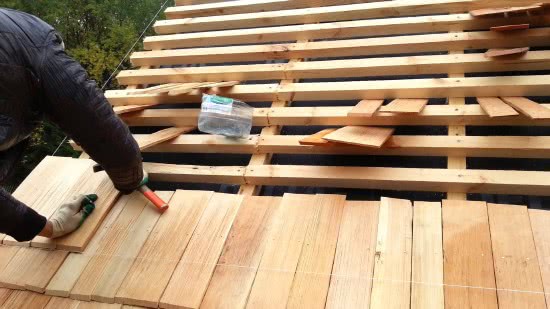
Let's talk about the process of manufacturing and installing spruce shingles.
To make spruce shingles, you will need spruce round timber. When calculating the number of round timber, it is necessary to take into account the quality of the material, the dimensions of the roof and the number of roofing layers.
First, the logs are prepared. To do this, the round timber, which has no knots, is sawn into pieces 40 cm long. The sawn logs are placed in a cauldron (metal barrel) and boiled for about half an hour - this allows the wood to slightly steam. After this, the log is placed vertically and with the help of a plow they begin to peel the shingles.
The thickness of the peeled shingles should be no more than 1 cm. Then the still wet shingles are stacked. It is necessary to provide a spacer between the layers. After the shingles have dried a little, they can be laid on the roof. It is advisable to first remove the bark (sand) from the sides of the shingles.
Actually, you don’t have to cook the logs. Then all cut logs must be immediately painted over at the ends with thick oil paint - this will prevent cracking of the wood. After this, the logs are placed to dry (also with gaskets) indoors or under a canopy.
Materials imitating shingles
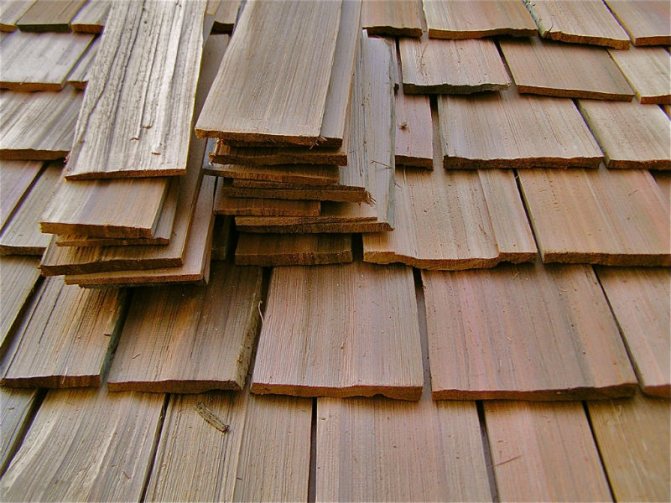
Siding imitating shingles
There are building materials on sale that look similar to their natural counterparts, but have a different composition:
- copper shingles, which is a metal profile with adjusted geometry and shaped like squares, diamonds or scales;
- plastic siding with an imitation of a wooden surface, combining moisture resistance with low weight;
- polymer artificial shingles, the quality almost matching the original, but containing toxic components.
The finished roof made of natural shingles looks aesthetically pleasing, solid and harmonious with the facade. If you need to save money, you can purchase materials that imitate the appearance of such a coating, but their performance characteristics are usually not so good.
Roofing device
Scheme for laying shingles
Roofing shingles are light in weight. The flooring is carried out over a continuous or thin lath, for the manufacture of which bars 6 cm thick are taken. The distance between the 4-layer covering and the bars is 25 cm.
The shingles are laid towards the ridge. Shortened plates are used for the first row of the first and second layers. The wooden plates of the first layer are fixed with the lower end to the board, and the upper end to the block.
The material is fastened with nails 5 cm long so that they go through the layer that precedes the one that is being laid.
Advice. In order to prevent the shingles from being subjected to wind loads, it is necessary to hem the overhang of the eaves from the lower surface of the rafters with lanyards.
What is a wooden roof
We know many architectural monuments of antiquity, and most of them are covered with wood. In forest-rich Russia, this was the best and most affordable roofing material. However, today's fashion for wooden roofs comes not from Russian antiquity, but from modern Europe. They did not stop using wood for these purposes, since modernizing old houses in Holland, Switzerland, and France is prohibited by law.
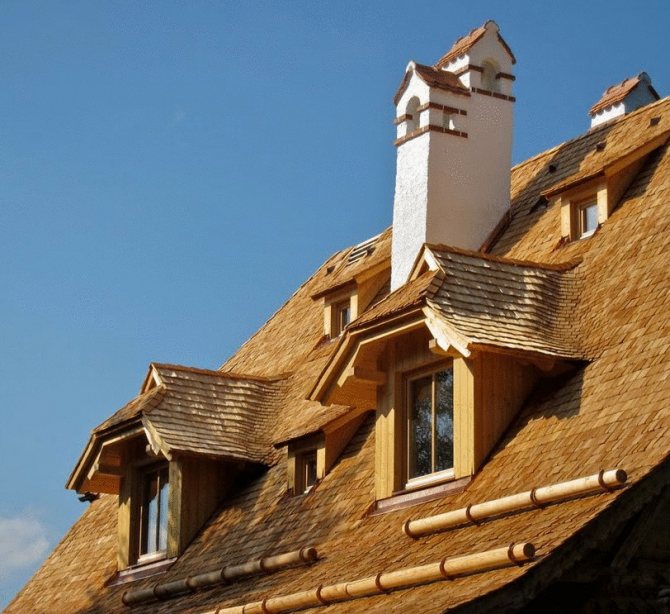
Shingled house in the Swiss Alps is protected by the state
A wooden roof in the most general sense is a roof made entirely of wood, with the exception of fastening materials - nails or screws. Although in ancient Rus' the fastening spikes were also made of wood. Let us at least remember the famous churches that have survived: in Spas-Vezhi (1628), Yuryev (1718), Yanidor in the Perm region (1702), Varzuga in the Murmansk region (1674), Kizhi on Onega Island (1714).
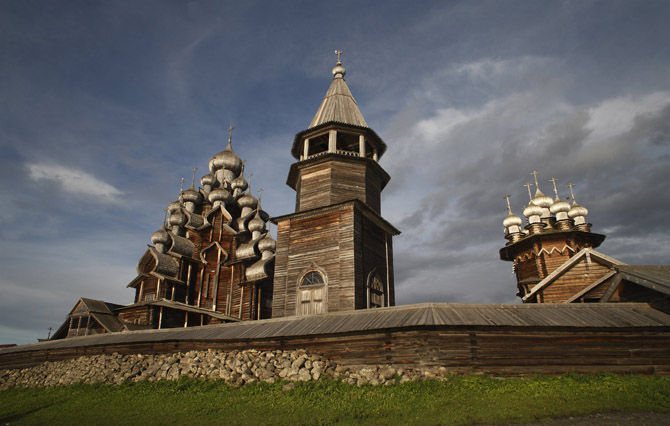
The Church of the Transfiguration of the Lord in Kizhi was built without a single metal fastening element
Advantages and disadvantages of wooden roofing
Fashion is fashion, but we need to understand what we are up to in our quest to make our home beautiful.
The advantages of such a roof are very significant:
- Aesthetics. Of course, your house will stand out from everyone, as Baratynsky said, “with a unique expression.”
- Economic factor. Such a roof does not require the installation of noise, thermal, hydro and vapor barriers, nor ventilation in the under-roof space. The “shards” work like a fir cone: when dry, they “breathe” and do not allow condensation to form under the roof, and when wet, they swell and close tightly.
- Excellent performance characteristics. The roof can withstand heavy snow loads, strong winds, high humidity, precipitation, large temperature changes, and protects residents from the noise of rain and wind.
- Eco-friendly and hypoallergenic. It does not emit harmful fumes either inside the house or into the environment.
- Fairly high durability. However, this directly depends on the type of “shards”, the type of wood and the thoroughness of installation. An oak or larch shingle will last up to 80 years.
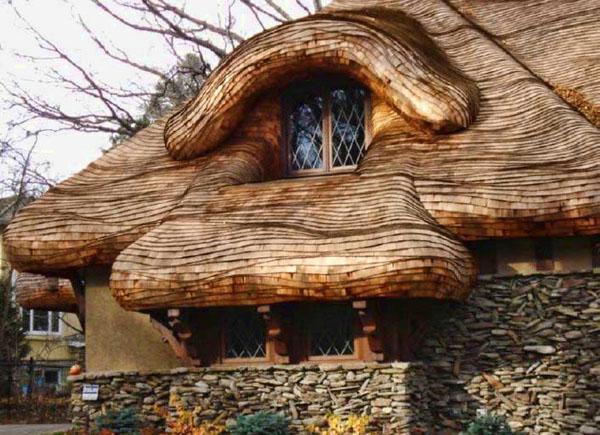
A house of an unusual shape, covered with shingles, has an “uncommon expression”
Of course, there are also disadvantages:
- Fragility in case of improper installation or use of unstable wood. A roof made of aspen shingles is designed to last only 8 years, and a roof made of pine planks - up to 20 years.
- High cost of material and labor.
- In the case of independent execution, there is a large labor cost for installation, which implies scrupulous fixation of each, often very small, element.
- Low fire resistance. Some danger remains even with careful impregnation of each element with modern fire retardants, proper design of fire-fighting materials around the pipe areas and installation of anti-spark deflectors on pipes and lightning rods.
- Strict requirements for the slope of the slope. A wooden roof does not rot or leak even with a fairly large roof slope - from 18 to 70°, ideally 40-45°.
Classification of roofing material
There are many classifications of roofing material, differing from each other in the size and shape of the plates, production method and much more. Let's look at some of them.
By plate size:
- regular (length 350.450 mm);
- long (length about 80 centimeters). Used for large roof areas.
According to the shape of the plates:
- rectangular;
- square;
- semi-oval.
By production method:
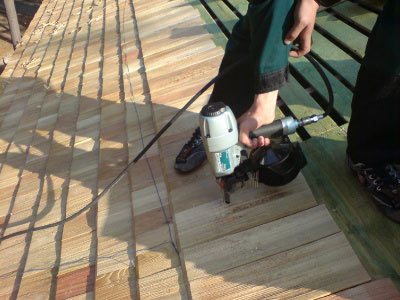
Installation of shingles is a complex and long-term process.
- Sawing is a cheap way to produce shingles. During sawing, the natural structure of wood fibers is disrupted, so it is short-lived.
- Chopped shingles. It is reliable and has a long service life.
By type of wood used:
- Aspen.
- Oak and Siberian larch are the best materials for roofing. They are not susceptible to the damaging effects of rain, sun and mold. Thanks to these properties, if properly manufactured and installed, the roof will last 100 years or more.
- Canadian cedar. Roofing made from this tree has gained popularity among roofers due to its amazingly beautiful crimson color. Over time, the color changes to gray.
Preparing chocks
To make a high-quality and durable roof from shingles, you need to prepare with your own hands or buy thin wooden blanks, most often called chocks. The plates that make up the shingle roof are made from pine, spruce, deciduous or aspen wood, cleared of bark, in one of two ways:
- Manually. To make chocks for making a shingle roof with your own hands, you need to buy even logs, and then split them into 2 halves and cut out the core. Whatever remains after cutting out the core is split into thin plates of approximately the same size.
- Industrial. The industrial technology for manufacturing shingles is different in that the log is divided into larger logs, which makes it possible to make the logs longer to make it easier to cover large areas of slopes.
Important! Although the price of industrially produced shingles is not that high, it is better to make chocks for shingle roofing with your own hands. The fact is that the blanks are made manually by splitting, not sawing, which disrupts the structure of the wood fibers.
